2025 Rivian R1S Atones for Some of Its Dynamic Sins
An automaker's first product says a lot about its plans. Its second go-round is arguably more revealing, showing how it has matured. Rivian has now released what it's calling the second generation of the R1 lineup. We had a go in the 2025 R1S, and, although you wouldn't know by looking at it, there's a lot of maturity to cover.
Suspension of Disbelief
Some good news off the bat: Rivian is listening to its customers and critics like us. We weren't the only ones to point out the SUV's dynamic deficiencies, which were stark in comparison to the well-sorted R1T pickup's characteristics, and the engineers took our constructive criticism to heart. To recap, the first-gen R1S exhibited a few ride and handling quirks. The front and rear ends weren't on the same page with their responses, and the steering wheel felt out of phase with the vehicle. We also noted the SUV's tendency to squat under hard acceleration, with executive editor K.C. Colwell likening the behavior to a speedboat taking its time to get on plane.
The 2025 R1S's suspension overhaul includes spring rates made softer up front and stiffer in the rear, updated bushing packs and top mount rings, an updated hydraulic roll-mitigation system, and new tuning for the adaptive dampers. The R1T's suspension was largely left alone, although the updated bushings and top mounts are shared between the two models. The pickup's ride and handling, for the record, are unchanged.
Gone are nose-to-the-sky launches (confirmed at a drag strip) courtesy of the firmer rear springs, and head toss has mostly been quelled by the roll-control updates. The whole vehicle functions as more of a piece now, from steering-wheel input to chassis response.
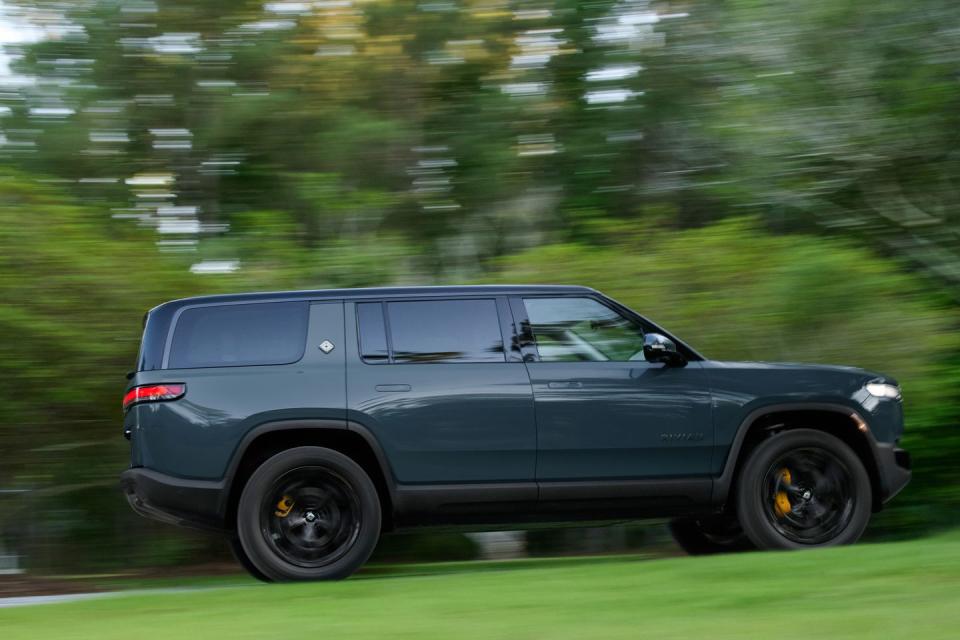
Two quibbles remain. Front-to-rear porpoising has been reduced, but the rear is now noticeably underdamped, causing even minor imperfections like highway expansion joints to elicit a bit of bobbing out back. A Rivian chassis engineer is hopeful they can reproduce this issue and address it with a software update, potentially with an adjustment to the suspension's load-compensation algorithm. And the suspension will hit the bump stops on the highway, the explanation being that suspension travel is limited in the lowest ride height setting, which aims to lessen aero drag. Rivian did make the bump stops softer and longer to provide a more progressive response, and although you feel the interaction it's at least not harsh. Partial credit there.
A Rainbow of Power
Fine, but you came here for big numbers, right? They are not in short supply. The Dual-Motor configuration, which uses a motor at each axle, is unchanged with 533 horsepower and 610 pound-feet of torque. The same goes for the Dual-Motor Performance spec, which uses the same hardware but adjusted software to produce 665 horses and 829 pound-feet. These models are subtly discernible by their silver brake calipers and black badge outlines.
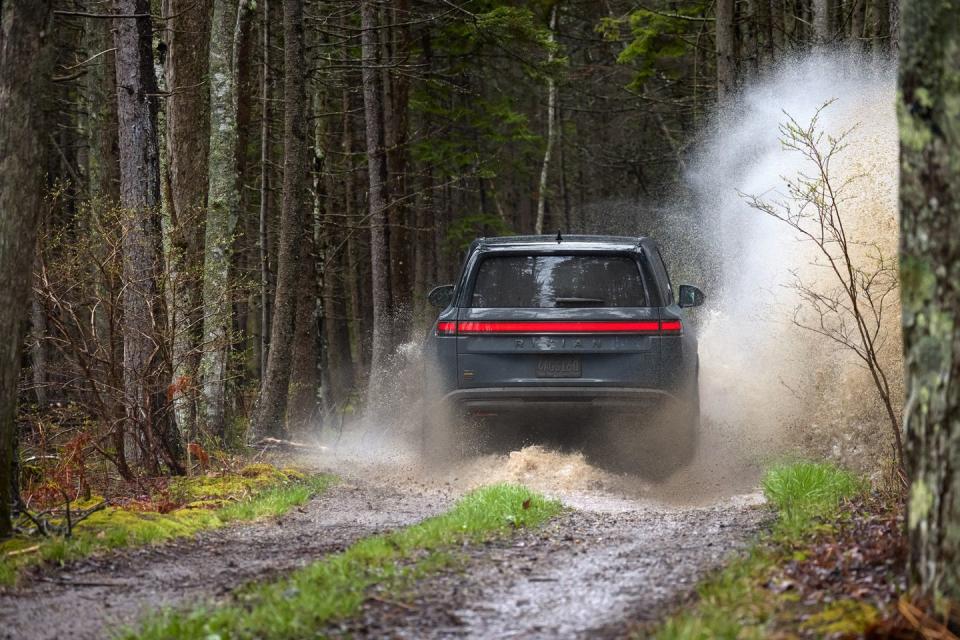
Sane folks would stop there, but here we go: A new Tri-Motor powertrain is perhaps the mullet of the lineup, with the Dual's single-motor unit up front and the Quad-Motor's two-motor unit in the rear. Power from the Tri-Motor surpasses that of the outgoing Quad-Motor at 850 horsepower and 1103 pound-feet of torque. The Tri gets yellow calipers and badge outlines, which, if you're really in the EV weeds, you'd know used to adorn the Quad-Motor models. We're not done yet. The Quad-Motor breaks into the quad digits with 1025 horsepower and 1198 pound-feet of torque. (We don't think the 5-hp advantage over the Tesla Model X Plaid is a coincidence.) The accent color to watch for here is teal, and the Quad's liftgate wears an adorable badge depicting Rivian's mascot, a yeti named Gear Guard, with his fur being blown back due to all that power. Both the Tri and Quad now use Rivian-designed motors in place of the Quad's previous Bosch units. The Dual-Motor's two motors were already fully in-house designs.
Because absolute power melts rubber absolutely, Rivian has upped the tire game to match. The Quad gets Rivian's first set of staggered wheels and tires, using 22-inch Michelin Pilot Sport S5 rubber with 275 section width in front and 305 in the rear. That setup is claimed to be good for a sub-2.5-second 60-mph run. And speaking of mass, Rivian hasn't provided final figures but expects curb weights to be about the same as on first-gen models. The R1S Tri should hit 60 in around 2.9 seconds, which compares favorably to the 3.1-second run we did with a 2022 R1S Launch Edition. The Quad even gets a higher top-speed limiter, upped from 111 mph to 130, so it won't hit an accelerative wall before the end of the quarter-mile like it did before. As always, instrumented testing is in order to test these claims, but we can say it's move-your-esophagus-to-the-back-of-your-neck quick.
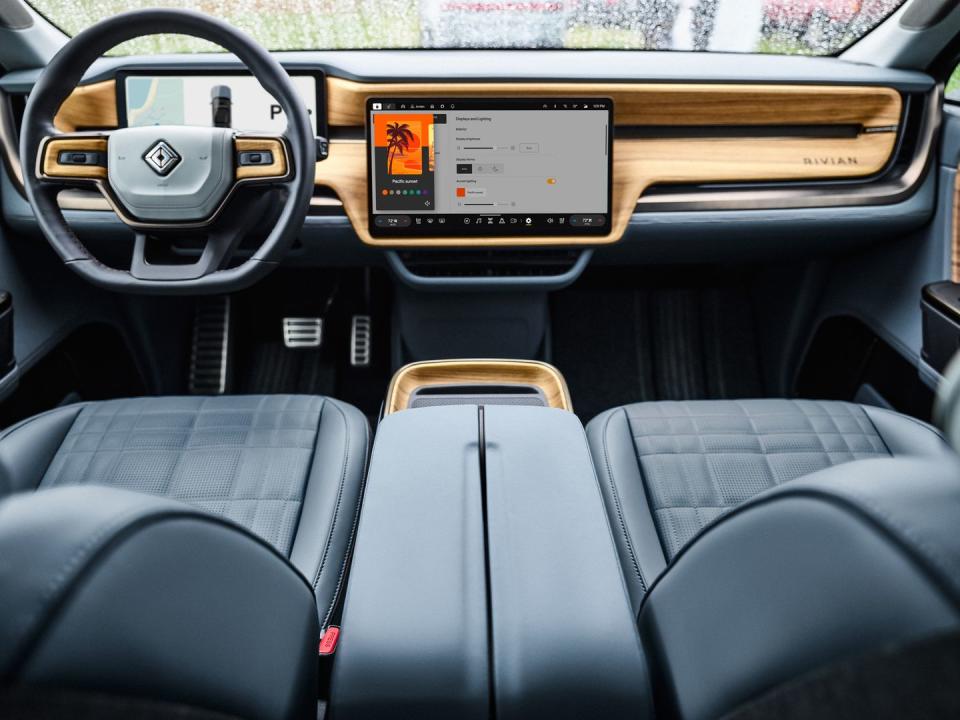
Other, less outrageous tire-and-wheel combos will be available, all with specs unique to Rivian. A 22-inch Pirelli Scorpion M+S tire mounted to an aero wheel with a removable center spat (to save it from rock-induced carnage off-road) is supposed to combine the former 21-inch tire's range with the performance of the outgoing 22-inch package. An EV-specific Goodyear Adventure tire strikes the balance between on-road manners and off-road abilities.
You'll need to supply juice to those healthy motor arrangements, and Rivian is once again offering three pack sizes: Standard, Large, and Max. The base battery now uses lithium-iron-phosphate chemistry, which it shares with Rivian's delivery vans. It has 92.5 kilowatt-hours of usable energy, and max range is estimated to be around 270 miles with a Dual-Motor.
The Large and Max packs have been reengineered, still using 2170 cells, and are now held in a die-cast carrier instead of one made of extruded aluminum, which saves weight and has added benefits for manufacturing and servicing. Large would now be more appropriately named Medium, as it has usable capacity of 109.4 kilowatt-hours compared to the previous Large's 128.9 kilowatt-hours. The Max pack improves slightly, with 141.5 kilowatt-hours usable. Combining that pack and the Dual-Motor's minimal energy needs, range should be around 410 miles. The Tri's performance won't be far behind, at least in EPA land, since it uses the same front motor as the Dual, and it and all Rivians can disconnect their rear motors for efficiency.
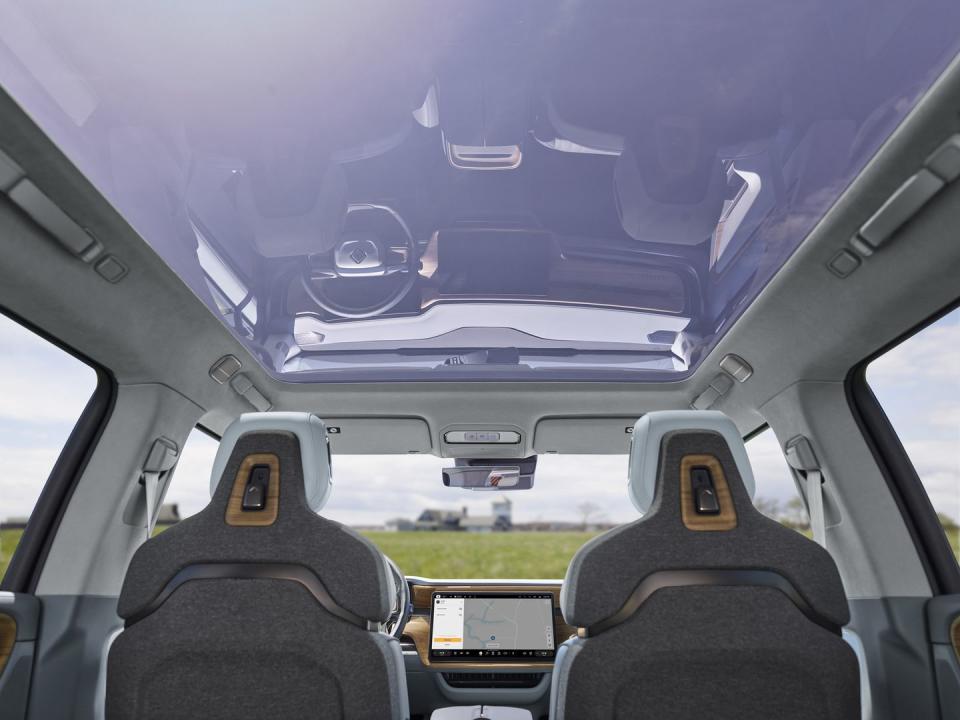
Looks the Same, Except Where It Doesn't
Okay, so growing up usually involves a physical transformation. Rivian chose instead to focus on improving the stuff you don't see, but there are some tells that you're looking at or riding in the newest one. (Full disclosure: We were picked up from the airport in a 2025 R1S and didn't know until the driver told us.)
Rivian's signature lighting elements got some love in the update. There's still a light bar spanning the front and rear, and the "stadium"-shaped headlight units are still present, although all of that has been reworked and has more visual interest and depth. The light bars now feature 10 RGB light segments that can display animations, including one to show charging progress and some that are intended to direct traffic around your stopped vehicle. There was also a mention of an update to Rivian's Halloween mode that may be forthcoming.
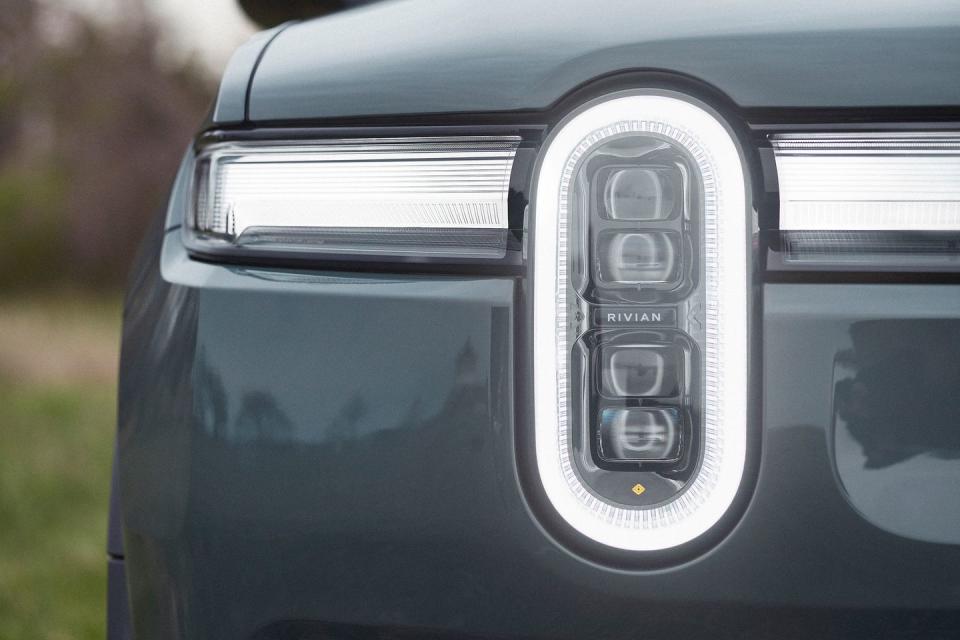
The squoval headlights get new guts that enable several features. Available now is an adaptive function called Dynamic Bending Light. Rivian is working to finalize its Adaptive Drive Beam feature, which is similar to the matrix LED feature that's been promised by several automakers over the years and is now legal in the U.S. It can enable or shut down individual LEDs to create a light pattern with maximum coverage while not blinding oncoming motorists. Depending on when Rivian sends out that software update, it may be the first company to offer such a feature in the States.
The turn signals have been moved out of the headlight units and down to the bumper where the fog lights used to reside, while the front fog lights have been moved to, well, nowhere. Upon noticing this, we were told to expect them to return via a headlight software update.
The company is also introducing what it calls the Rivian Autonomy Platform to enable new features and increased automation down the line. It uses 11 cameras of higher quality than before, as well as five radars to sense its surroundings, and then has its AI, which is built on top of NVIDIA DRIVE Orin hardware, make ADAS decisions. The existing Highway Assist function falls into this category.
RAP is standard on the new models, and the more-advanced version, Rivian Autonomy Platform+, will be included on all R1s sold this year. The first such feature, Lane Change on Command, executes lane changes by itself when Highway Assist function is active. We found it to be on the assertive side, but Rivian noted that the tuning isn't quite finished. And whether you or the vehicle decide when to change lanes, the gauge display shows the camera feed from the mirror on that side to make you feel better. You could also check your mirrors. Enhanced Highway Assist will follow and uses a camera hidden behind the rearview-mirror glass to monitor the driver. Rivian made big changes to the electrical architecture, which you can read about in our 2025 R1T review.
The big interior upgrade is also software-based. Rivian has redone its user interface, replacing still photos of its vehicles with cel-shaded drawings that morph to show a change in drive modes. Still no Apple CarPlay or Android Auto, but plenty of smartphone-esque features have been added. You can use an iPhone, Apple Watch, or select Google Pixel phones as your key. Included with Rivian's Connect+ subscription is a native version of Apple Music that can provide Dolby Atmos spatial audio to the newly available premium in-house sound system. A Google Cast function lets you send video to the big center display when parked, and Connect+ also includes Spotify, Tidal, and Alexa access. The interface is nice to look at, and there is obvious attention to detail, although there's still work to be done—it's impossible to tell status icons across the top row from buttons, functions like steering-wheel and mirror adjustments still take too many taps, and certain features simply aren't discoverable. But here again, Rivian promises to make changes through updates.
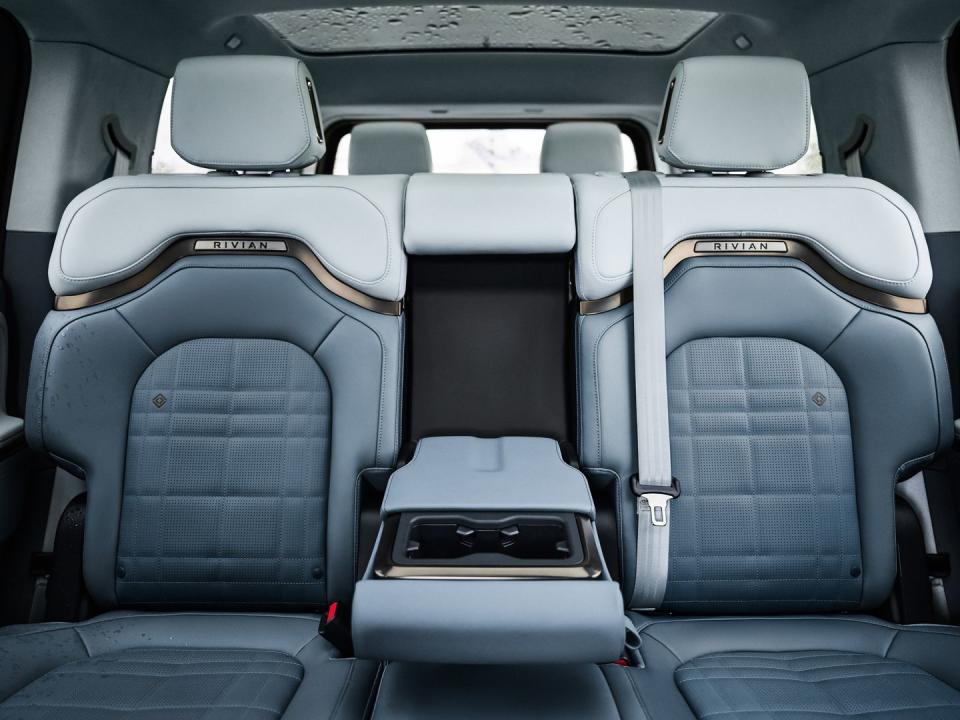
The R1's main door releases are now electronic, although the mechanical handle is still present up front, just painted black to blend in. Why? We were told this is to commonize parts between the R1 models and the upcoming R2. This left us with another unanswered question: Why does the R2 need electric door releases? We'll have to wait awhile to find out.
The original Adventure trim lives on for Dual-Motor models, while a new Ascend trim is standard on Tri and Quad and brings some improvements, like more wrapping and stitching on the door lower panels, map pockets, and lower IP. Ascend also brings new interior color combos and plaid for the door-pocket elastic, the technical-looking straps on the backs of the front seats, and in an enlarged version on the floor mats that almost doesn't look like plaid.
Revamped suspensions aren't free. The R1S's price increases by $1000 for the base model, now $77,700. R1S Dual-Motor configurations are available immediately, with Tri-Motors expected in late summer and the Quad-Motor to follow after that.
You Might Also Like

 Yahoo Autos
Yahoo Autos 